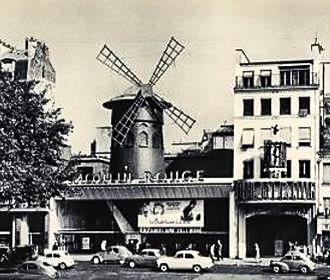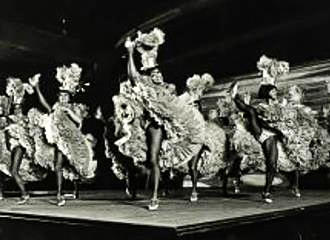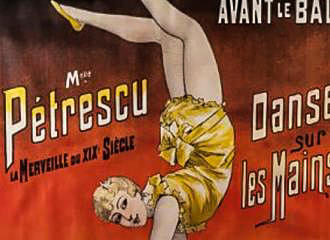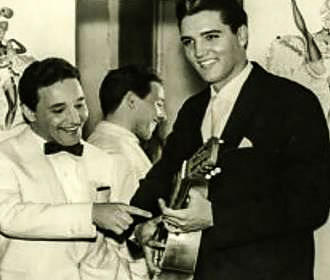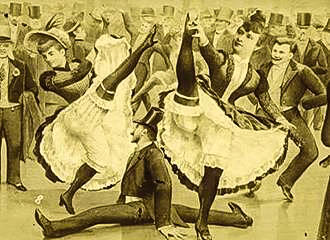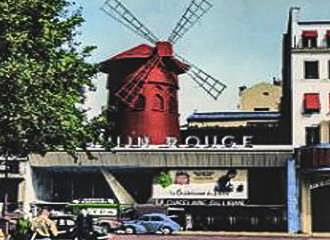Paris Moulin Rouge history started in 1889
The Montmartre area of Paris was frequented by many writers and painters such Toulouse-Lautrec who all drew their inspiration from this diverse area of the city, yet was also a place known for night time pleasures with many different cafes and music halls for people to enjoy.
Moulin Rouge history start of the Belle Epoque era
And due to the Industrial Revolution in France, this was also the start of the Belle Epoque era, where people were becoming more liberal and workers were starting to be joined by the middle class in the same venues.
It was at this time that the Eiffel Tower was built by the renowned engineer Gustave Eiffel and only a few years later the Sacre Coeur Basilica was inaugurated at the top of the Montmartre hill, and it was hoped that this holy place would bring more prestige back to this area of Paris.
However, this was not to be the case as more and more aristocrats and socialites were also starting to frequent this area in search of night time pleasures and sit at the same tables as workers enjoying laughter and frivolity.
Then came the idea of an entirely different cabaret style music hall venue that would be elaborate and unusual and it was the brainchild of the founders Joseph Oller, who originally came from Spain and was once a bookmaker and Charles Zidler, who came from Paris and originally trained as a butcher before going into the show business world.
Start of the Paris Moulin Rouge history
So this period in the history of Paris was the beginning of the Moulin Rouge Cabaret, and decorated with mirrors everywhere, a large dance floor, the extravagant decoration, not forgetting the famous red windmill on top and the elephant in the garden, it first opened its doors on the 6th October 1889.
Now the Paris Moulin Rouge Cabaret was designed to be a complete mix of elegance, quirky and unusual features along with a wild atmosphere where aristocrats could mix with riff-raff and girls of easy virtue. Women could ride a donkey in the garden for pleasure and the men could just have a large amount of fun, laughter and euphoria in an entertainment establishment that had never been known like this before.
And the founders of the music hall cabaret venue in Paris nicknamed the project Le Premier Palais des Femmes, which translates to The First Palace of Women, and even though there was much scepticism at the initial idea of this ever becoming a temple to music and dance, on the opening night it was a resounding success, and all hopes were fulfilled.
The balls, as they were known, at the Paris Moulin Rouge quickly became well known events, especially with their grand finale where the public in Paris got to experience the new dance called the French Cancan for the very first time. Now the Paris Moulin Rouge history regarding the French cancan shows that this was the newer version of the old Quadrille and it was designed to turn heads, which it did! yet many scorned at this unruly boisterous rhythm of dancing that did not conform to previous morals. But the Chahuteuses, or unruly girls who all had different stage names, brought in the crowds and some like the famous La Goulue were immortalised in paintings.
The first ten years of the Paris Moulin Rouge Cabaret Nightclub were those of outrageous and extravagant nights with cabarets that was more related to, and inspired by circus acts apart from the French cancan, but by the end of the century, this type of entertainment was falling out of favour and on 26th November 1902, the last ball was performed.
Paris Moulin Rouge History Next Stages
As time went on the Paris Moulin Rouge Cabaret then became a concert theatre under the guidance of Paul-Louis Flers who was already a well known revue director, and the idea to was bring this cabaret venue in Paris back up to a more respectable and prestigious place.
So up until the start of World War I, and with many different managers, the Paris Moulin Rouge Cabaret Nightclub became a temple dedicated to operetta, but with many different revues and shows, this meant that each revue had its own title and over time these titles were becoming more and more evocative in order to get the people in for an evening of laughing, crying, and many other emotions.
After World War I, the Paris Moulin Rouge cabaret was taken over by the businessman Francis Salabert, who employed Pierre Foucret to brighten up the Great Revue along with Jacques-Charles who was the Revue Director at that time. The idea was to have American dancing girls, and they managed to convince Gertrude Hoffmann of Hoffmann Ballet to join them in order to put together a new revue in the Broadway style, and it was called New York Montmartre.
Mistinguett, who was the instigator of the swaying waltz, had previously made her debut on the stage of the Paris Moulin Rouge and on the opening night of the New York Montmartre Revue, she was in the audience. By this time she was known as the Queen of Music Hall and she saw the impact this show had, but also how the Paris Moulin Rouge could once again become the shining star of all cabarets in Paris, and so she team up with Jacques-Charles to create some of the most legendary revue creations until they retired in 1929.
Yet the golden age of cinema was taking over and the great revues were losing their popularity and the Paris Moulin Rouge ballroom became a nightclub, even though there were different shows that took place from time to time, but then came the start of World War II.
It was no doubt some of the darkest years for the Moulin Rouge, especially whilst Paris was under German occupation and the only ray of sunshine was the voice of Edith Piaf, who became a renowned star on the stage of the Moulin Rouge and held a show at this cabaret venue only days before the Liberation of Paris.
But it was a few more years before the Paris Moulin Rouge was to return to its former glory and depicted that image of entertainment, which is so synonymous with this particular cabaret venue.
Revival of the Paris Moulin Rouge Cabaret
The June of 1951 saw a change of ownership, when Glourges France purchased the Paris Moulin Rouge in order to renovate it and once again let this famous venue hold nights of Paris entertainment for all to enjoy.
Regaining its impressive and elegant interior, dance parties and entertainment nights were regularly held, particularly those for charity, with one being called the 25th Bal des Petits Lits Blancs, which was a charity ball for hospitalised children organised by the author Guy de Cars.
Then in 1955, Joseph and Louis Clerico took over the Paris Moulin Rouge cabaret and were joined by Jean Bauchet to bring the venue up to more modern day expectations, yet still with the traditions that brought this cabaret venue alive.
And it was at this time that a major change was made, as a kitchen was fitted, and hence the dinner show of the Paris Moulin Rouge was first born. News of this change soon spread and with prestigious performers along with budding stars of tomorrow, people started to come and enjoy an evening at the Paris Moulin Rouge for the dinner show and it became one of the well known Paris tourist attractions.
By 1962 Jacki, who was the son of Joseph Clerico, took over the running of the Paris Moulin Rouge Cabaret and two years later he embarked on a venture to build a giant aquarium, and much to the astonishment of clients, it had nude or nearly nude dancers that moved about like mermaids!
Jacki only ever chose names for the revues that began with the letter F and a couple of these were called Fascination and Frenesie. But one revue called Formidable was produced to mark the 100th anniversary of the Paris Moulin Rouge Cabaret that was enjoyed by some of the most renowned stars, politicians, international celebrities, etc, and this particular show remains in the hearts of many.
Yet even today, in keeping with the traditions of Jacki Clerico and for superstition, each new revue produced for the ever popular dinner show at the Paris Moulin rouge, always has the name starting with the letter F.
